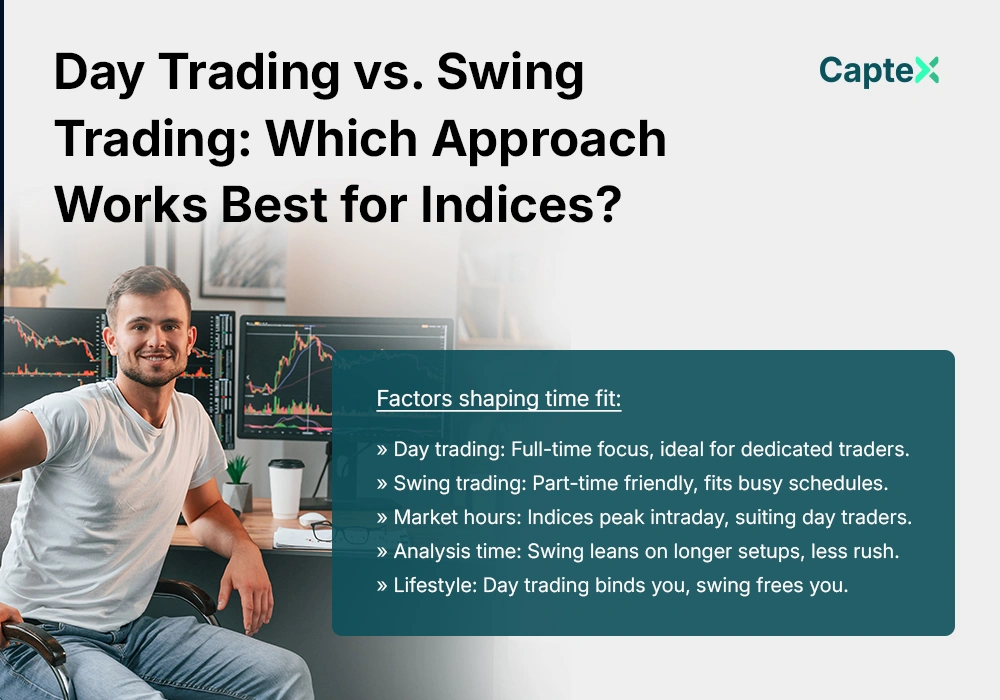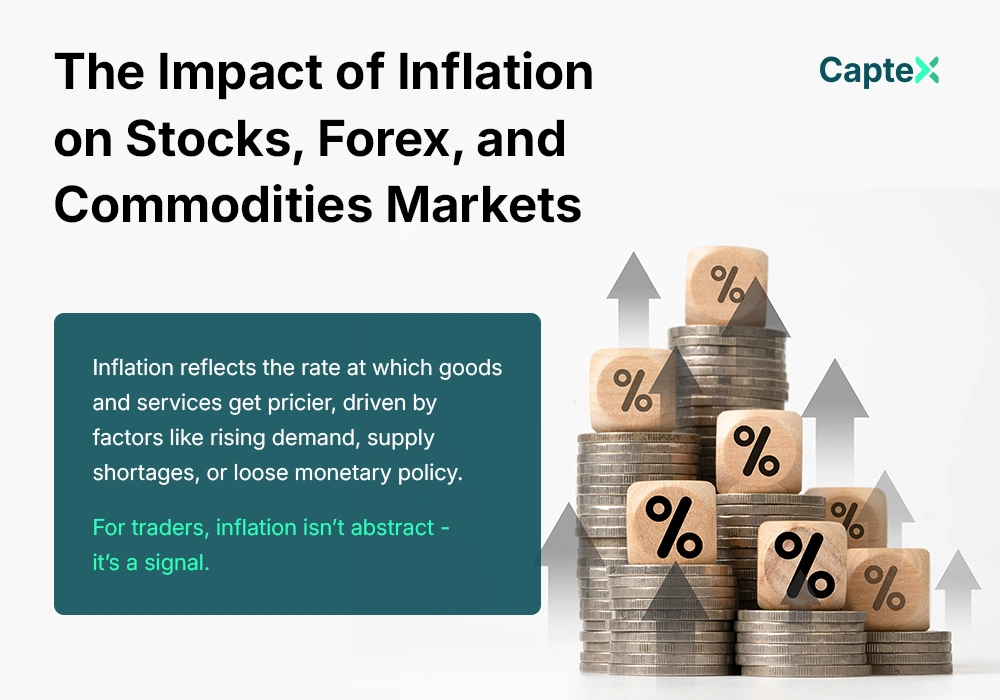Trading stock indices offers a window into broad market movements, blending opportunity with volatility. Two popular approaches—day trading and swing trading—cater to different styles, goals, and time commitments. Day trading thrives on speed, capturing intraday shifts, while swing trading seeks bigger moves over days or weeks. Which suits indices best? Let’s compare their mechanics, strengths, and fit for index trading to help you decide.

Understanding Day Trading Basics
Day trading involves buying and selling within a single session, closing all positions before the market shuts. For indices, this means riding quick price swings driven by news, economic data, or sentiment shifts. Traders might target a 20-point move on a major index, using leverage to amplify small gains. Speed and precision define this game—no overnight risks, just rapid-fire decisions.
The pace suits active traders glued to screens, reacting to every tick. You’re not predicting long-term trends but exploiting short-term inefficiencies. It’s high-energy, demanding focus and a knack for cutting losses fast. For indices, with their intraday volatility, day trading offers a playground—if you can handle the heat.
Understanding Swing Trading Basics
Swing trading stretches the horizon, holding positions from a few days to weeks, aiming for larger price shifts. On indices, this might mean catching a 100-point trend after a breakout or reversal. Traders analyze daily or 4-hour charts, banking on momentum or mean reversion to play out. Patience is key—you’re riding waves, not ripples.
This approach fits those with less screen time, letting trades breathe overnight. It leans on broader market patterns, like earnings seasons or policy shifts, rather than minute-by-minute noise. For indices, with their tendency to trend over days, swing trading aligns with capturing meatier moves without constant monitoring.
Time Commitment and Lifestyle Fit
Day trading demands full immersion—hours watching charts, news, and order flow. A typical session might start pre-market, scanning for catalysts like jobs reports, then executing trades until the close. For indices, where liquidity peaks during regular hours, you’re locked in from bell to bell. It’s a job, not a side gig, favoring those with flexible schedules.
Swing trading is lighter on time. You might spend an hour daily—reviewing charts, setting orders, and checking positions. It suits traders balancing work or life, as overnight holds don’t require babysitting. Indices’ smoother trends over days make swing trading less stressful, letting you step back while still staying engaged.
Factors shaping time fit:
- Day trading: Full-time focus, ideal for dedicated traders.
- Swing trading: Part-time friendly, fits busy schedules.
- Market hours: Indices peak intraday, suiting day traders.
- Analysis time: Swing leans on longer setups, less rush.
- Lifestyle: Day trading binds you, swing frees you.
Risk and Reward Profiles
Day trading’s risk-reward dances on a tightrope. Small moves—say, 0.5% on an index—can yield big returns with leverage, but losses mount fast too. A string of bad trades can wipe gains, and slippage or spreads nibble profits. Rewards come quick, though—multiple wins daily stack up if you’re sharp.
Swing trading plays a wider field. A 2% index swing over a week offers heftier gains per trade, but overnight gaps (from news or events) can sting. Risk spreads over fewer trades, easing emotional whiplash, yet requires bigger stops to weather volatility. For indices, with their multi-day trends, swings often net more—but patience pays the price.

Tools and Indicators for Day Trading Indices
Day traders on indices lean on fast tools. Scalping with 1-minute or 5-minute charts, they use RSI to spot overbought dips or MACD for momentum shifts. Volume spikes signal entries—say, a surge after a Fed comment. Tight Bollinger Bands hint at breakouts, critical for indices’ intraday jolts.
Real-time data feeds and Level II quotes refine precision, especially on liquid indices. Stop-losses—set at 0.2% below entry—cap risk, while trailing stops lock gains. The toolkit’s built for speed, matching indices’ intraday rhythm where seconds count.
Tools and Indicators for Swing Trading Indices
Swing traders favor broader lenses. Daily or 4-hour charts reveal trends—50-day moving averages confirm direction, while Fibonacci retracements peg support zones. ADX above 25 validates strength, ideal for indices’ sustained moves. Candlestick patterns, like a bullish engulfing at a low, signal entries.
Less urgency means deeper analysis—pair technicals with earnings calendars or rate decisions. Wider stops (1-2% of index value) absorb overnight noise, and profit targets stretch to key levels. For indices, this setup catches the bigger picture without micromanaging.
Swing trading toolbox:
- Moving averages: Track multi-day trends.
- Fibonacci: Pinpoint reversal zones.
- ADX: Gauge trend power.
- Candlesticks: Time entries with precision.
- Economic events: Align with catalysts.
Volatility and Market Conditions
Indices shine in volatility—day traders feast on it. Sharp moves from news—like a surprise rate hike—offer quick scalps, especially on high-volume days. Choppy, low-volatility markets frustrate them, flattening opportunities. Indices’ intraday swings, tied to data releases, fuel this style when action peaks.
Swing traders thrive in trending conditions. A steady uptrend after a policy shift suits their hold-and-wait game. High volatility can disrupt, though—gaps against your position hurt more over nights. Indices’ tendency to consolidate then break suits swing plays, but timing the trend is critical.
Capital Requirements and Costs
Day trading indices demands heftier capital. Leverage boosts small moves, but margin rules—like a $25,000 minimum for U.S. pattern day traders—set a bar. Frequent trades pile up fees—spreads, commissions, data costs—eating into slim margins. Efficiency’s a must; every pip counts.
Swing trading needs less upfront. Fewer trades mean lower fees, and holding overnight skips intraday margin calls. A modest account can catch a 100-point move with proper sizing. For indices, where leverage is common, swing’s lower churn keeps costs lean, stretching your capital further.
Psychological Demands and Discipline
Day trading tests your nerves—rapid decisions under pressure spark adrenaline and exhaustion. A losing streak can tilt you, pushing rash trades. Discipline’s non-negotiable: stick to rules, cut losses at 1%, and cap daily trades. Indices’ fast pace amplifies this mental grind.
Swing trading’s slower burn still challenges psyche. Holding through a dip—or resisting early exits—takes grit. Doubt creeps in overnight, but fewer decisions ease the load. For indices, where trends unfold gradually, swing demands trust in your setup over impulsive tweaks.
Which Works Best for Indices?
Day trading suits indices when you crave action and can commit fully. Their intraday volatility—spiked by news or volume—rewards quick hands. But it’s unforgiving—missed timing or high costs can sink you. Swing trading fits indices’ broader swings, like post-earnings rallies, offering bigger gains with less babysitting—ideal if you prefer strategy over speed.
Your pick hinges on you—time, risk appetite, capital. Day trading’s edge shines in volatile sessions; swing trading wins in trending markets. Test both on past index data—say, a month of 5-minute versus daily charts. Indices flex for either, but your style tips the scales.
Bottom Line
Day trading and swing trading both unlock indices’ potential, each with a distinct flavor. Day trading delivers fast profits amid intraday chaos, demanding focus and grit. Swing trading banks on bigger trends, blending patience with flexibility. For indices, neither’s “best”—it’s about your rhythm. Match your life, skills, and goals to the approach, and let the market’s pulse guide your profits.




